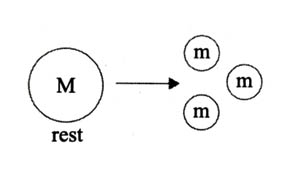Topic Question Set
Q 1
:
Binding energy of a certain nucleus is J. How much is the difference between total mass of all the nucleons and nuclear mass of the given nucleus [2024]
(2)
Q 2
:
If is the mass of isotope , and are the masses of proton and neutron, then nuclear binding energy of isotope is [2024]
(4)
Q 3
:
The energy equivalent of 1 g of substance is: [2024]
(4)
Q 4
:
The atomic mass of is 12.00000u and that of is 13.003354u. The required energy to remove a neutron from , if mass of neutron is 1.008665u, will be [2024]
62.5 MeV
6.25 MeV
4.95 MeV
49.5 MeV
(3)
Q 5
:
If three helium nuclei combine to form a carbon nucleus then the energy released in this reaction is _________ MeV. (Given 1u = 931 MeV/, atomic mass of helium = 4.002603u). [2024]
(727) Reaction:
Energy released
Q 6
:
A star has 100% helium composition. It starts to convert three into one via triple alpha process as . The mass of the star is kg and it generates energy at the rate of W. The rate of converting these is , where is _______ .
[Take, mass of = 4.0026 u, mass of = 12 u] [2024]
(5)
Power generated (N = No. of reactions/sec)
Rate of conversion of in
Q 7
:
In a nuclear fission process, a high mass nuclide (A 236) with binding energy 7.6 MeV/Nucleon dissociated into middle mass nuclides (A 118), having binding energy of 8.6 MeV/Nucleon. The energy released in the process would be _______ meV. [2024]
(236)
Q 8
:
The mass defect in a particular reaction is 0.4 g. The amount of energy liberated is kWh, where n = ______. (speed of light = m/s) [2024]
(1)
Q 9
:
In a nuclear fission reaction of an isotope of mass M three similar daughter nuclei of same mass are formed. The speed of a daughter nuclei in terms of mass defect will be [2024]
(3)

Q 10
:
Given below are two statements. One is labelled as Assertion (A) and the other is labelled as Reason (R). [2025]
Assertion (A): The binding energy per nucleon is found to be practically independent of the atomic number A, for nuclei with mass numbers between 30 and 170.
Reason (R): Nuclear force is long range.
In the light of the above statements, choose the correct answer from the options given below:
(A) is false but (R) is true
(A) is true but (R) is false
Both (A) and (R) are true and (R) is the correct explanation of (A)
Both (A) and (R) are true but (R) is NOT the correct explanation of (A)
(2)
From graph between B.E/N and A we can see BE/N is almost constant ⇒ correct
Reason ⇒ incorrect as nuclear forces are short range forces.

